Summary
Design Matters 8x8 was an exhibition compiled by Professor Richard Snell and was held across various locations showing 8 chairs from 8 decades. The text below is taken from the printed leaflet which accompanied the exhibition and includes a descriptive summary of each piece.
Foreword
The exhibition ‘8X8 eight chairs/eight decades’ is the third part of the Design Matters series of projects which have been developed by the Guernsey Arts Commission. Placing different aspects of design in the public arena has culminated in this final part, an exhibition about just one object, the chair. To get some rigour in our choice of the final eight chairs (each one reflecting a different decade) we have enlisted the School of Fashion, Textiles & 3D Design at Birmingham City University, and left the final choice of chairs to their Head of School, Professor Richard Snell. We are delighted to have worked in partnership with him and thank his staff who have helped so much in the realisation of this exhibition. Our thanks also go to David Rowe for his photography, David Heap for his excellent timeline, and Guernsey student Lauren Barnes for her personal take on relevant visual arts images. Also thank you to you, the audience, who are the whole reason the ‘Design Matters: 8X8’ project was devised and realised. Please linger and look at the chairs because only when they are removed from their function (as you can see, they are all working chairs) can you begin to fully appreciate their form, and acknowledge that everything we use has had to be designed at some time, and by somebody… Finally, we are extremely pleased that Guernsey premiers the show in the greenhouse which will now be touring, in July, to BCU and in September to The Bond in Birmingham.
Joanna Littlejohns
Arts Development Officer
Guernsey Arts Commission
Eight Chairs
This exhibition aims to raise awareness of the thinking behind the design of eight chairs, one from each of the last eight decades of the 20th century. Each chair can be seen as a ‘barometer’ of the period in which it was designed. In exploring this relationship of the product to its time the exhibition also highlights how contextual issues have been absorbed into the design process.
The Design Process
All eight chairs in the exhibition were designed to be produced in large numbers therefore they are works of design, rather than of art or craft. The design process involved would have included many considerations, for example
• the means of production
• materials
• cost
• function
In applying the process, the designer would have aspired also to an innovative approach informed by an awareness of contemporary issues and visual styles.
Why chairs?
The chair is an object that we have a close tactile, physical and emotional engagement with. For example, dining chairs, car seats, office chairs and favourite armchairs. Throughout the 20th century, the chair was also regarded as the definitive design test, encouraging artists, designers, architects and engineers to create a chair that captured their design philosophy.
Design Matters
These chairs from the 20th century show how designers addressed issues relevant to the period in which they worked. Designers of the 21st century are building on this approach, extending it to include today’s issues such as sustainability and impact upon the quality of life.
Prof. Richard Snell
1920s
Wassily, Designer: Marcel Breuer
Manufacturers: Mannesman Steel and leather
Standard-möbel, Berlin, Germany 1925-26
Wassily Chair / 1925
• The Wassily Chair was designed as a materials and seating experiment by the designer whilst teaching at the Bauhaus in Dessau – one of the most progressive design schools of the time.
• The design was inspired by the handlebars of the new Adler bicycle.
• Breuer was encouraged by abstract artist and Bauhaus colleague Wassily Kandinsky
to develop his initial experiments into a design for production.
• Intended for low cost production, the chair unashamedly proclaimed an aesthetic that captured the modernist philosophy of the Bauhaus.
• This chair is believed to represent a major turning point in 20th century design.
Marcel Breuer was an architect, product designer and design teacher. He moved to England in the mid 1930s and then to America to work with colleagues escaping from the Nazi regime in Germany.
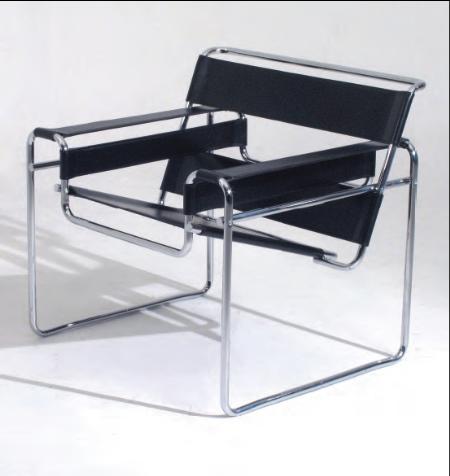
1930s
SP9 (Spring Pattern 9) Designer: Unknown Design influenced by contact with the London based architect Oliver Bernard. Manufacturer: PEL Ltd., Oldbury England 1932
SP9 / 1932
• PEL (Practical Equipment Ltd.) was formed in 1931 to help market the high quality steel tube produced by Accles and Pollock – both companies were part of Midlands based Tube Investments.
• Producing saleable furniture from steel tube proved very successful and a useful revenue stream given the economic conditions of the time.
• The cantilever design of this chair builds on the work of leading designers and manufacturers in Germany, Holland and Austria whilst promoting the tensile qualities and creative potential of the steel tube.
• PEL worked closely with many successful architects of the time including Oliver Bernard, Wells Coates and Serge Chermayeff.
• Initially PEL’s modernist tubular furniture was specified for avant-garde interiors, but with time PEL obtained substantial contracts from the railways, hospitals, universities and schools.
• The futuristic appearance of the SP9 proclaimed a technologically advanced world, hence its specification for new Broadcasting Houses in London, Manchester and Johannesburg.

1940s
BA3 Designer: Ernest Race, Manufacturer: Race Furniture, Sheerness England 1946
BA3 / 1946
• The BA range of chairs was designed to utilise aluminium recycled from decommissioned WW2 aircraft.
• Produced outside the restraints of the Utility Furniture scheme introduced during WW2, it signalled the birth of a new light and airy contemporary style.
• All of the BA range is cleverly engineered. It uses few components and the minimum of materials to generate strength and comfort as well as a refreshingly new look.
This design helped establish the tapered leg detail as a major visual element of the post-war style.
• Over 250,000 chairs were produced, mainly for use in public and commercial buildings around the world.
• The BA chair won the Gold Medal at the 10th Milan Triennale in 1951. Ernest Race was an architect, textile designer and furniture designer. He went on to design several ranges of furniture for the Festival of Britain in 1951.
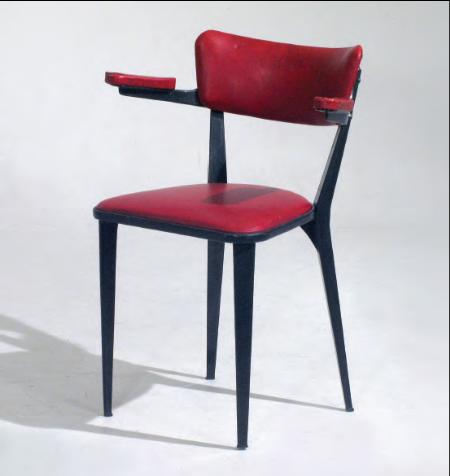 1950s
1950s
Diamond Model No.421L, Designer: Harry Bertoia, Manufacturer: Knoll International, New York USA 1953
Diamond Chair / 1953
• In 1950 Harry Bertoia was commissioned by Hans and Florence Knoll to develop objects for their contemporary New York furniture company, Knoll International.
• Initially Bertoia pursued a purely sculptural direction, but as he progressed he applied these ideas to furniture. The Diamond chair was part of this body of work.
• Bertoia worked with space, form and metal giving his furniture products a sense of lightness and transparency which integrated well with open plan modern interiors and captured the optimism of the post WW2 period.
• New York at this time was becoming a creative hub and designs such as these helped to dispel negative European perceptions of American products.
Harry Bertoia and Florence Knoll were both graduates of one of the most progressive design schools of the period, Cranbrook in Michigan. Whilst at Cranbrook, Florence was taught by Marcel Breuer (see 1920s chair).
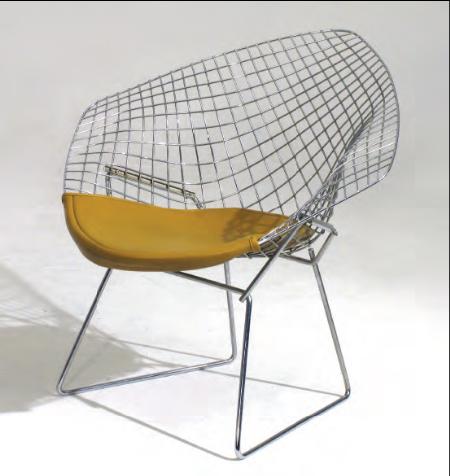
1960s
Universale Model 4860, Designer: Joe Colombo Manufacturer: Kartell, Milan Italy 1965
Universale Chair / 1965
• First stacking chair for adults to be produced entirely by the injection moulding of plastic.
• Designed during a period when Italian furniture designers were leading the world.
• Exploits technical developments in plastics and the technology to mould them.
• Product of a constructive working relationship between the designer and the Milanese plastic products manufacturer Kartell.
• The design allowed for different lengths of leg mouldings to be plugged into the seat and back form to create a child's chair, an adult's chair, and a high stool – all from four components.
• The designer drew inspiration from new ways of living, new materials and the futuristic film sets of the period.
Joe Columbo was an artist, architect and product designer.
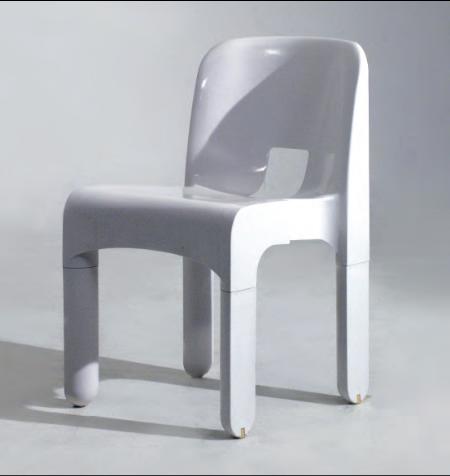
1970s
Omkstack Designer: Rodney Kinsman Manufacturer: Bieffeplast Italy Distribution: OMK, London England 1972
Omkstack / 1972
• This chair epitomises Rodney Kinsman’s designs for OMK. It is stylish, intelligently engineered and represented value for money in a time of economic gloom.
• The design utilises two basic materials (sheet metal and tubular steel) to great effect, producing a strong and light chair, ideal for stacking.
• Visually this chair looks back to Pop Art and forward to the high-tech style which was to grow in popularity during the 1970s. Consequently it was integrated into many interiors designed in the high-tech idiom.
• The non flammable materials and curved forms addressed increasing concerns for health and safety issues. The perforations in the seat and back allowed for outdoor as well as indoor use.
Rodney Kinsman is a product designer and entrepreneur. OMK was formed in 1966 by Kinsman and two other graduates from Central School of Art, London, each contributing their last name initial to the company name.
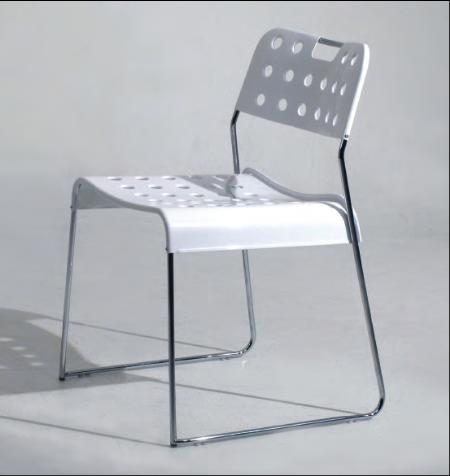
1980s
Neon Designer: Richard Snell Manufacturer: Hostess Furniture, Bilston England 1985
Neon / 1985
• During the 80s the British were adopting a more Continental and American attitude to ‘eating out’.
• Versions of the chair were produced for high street restaurants and fast food chains.
• The form referred to the bentwood chairs used in Viennese coffee houses at the end of the 19th century and also the American Diner style of the 1940s and 50s.
• This cross-referencing of styles was part of the post-modern approach. Post-modern designers used memory and historic referencing to dispel the neutrality of modernism.
• Use of a range of materials allowed for several back design options and surface finishes, including chrome, colour and natural wood, to be specified.
• Laser cutting, a new process in the furniture industry, was used to create the circular holes on the wood laminate back. This allowed contract purchasers to specify their own design.
Richard Snell is a design teacher, academic and furniture designer.
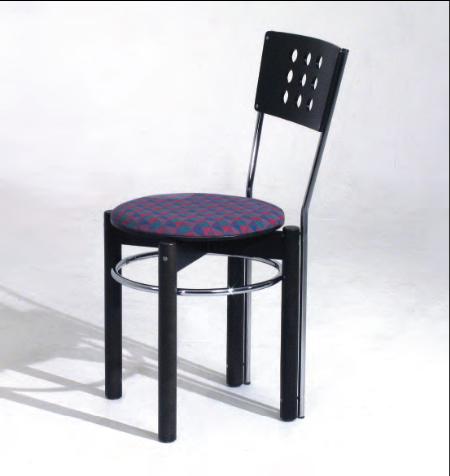
1990s
Meridio Designer: Michael Dye Manufacturer: Hille International, Haverhill England 1993
Meridio / 1993
• Michael Dye worked with contract furniture company Hille International, to address how healthy postural support could be provided for the variety of tasks performed in the office of the 90s.
• Hille had previously produced seating for the office sector, launching its ground breaking ‘Supporto system’ in the late 1970s, but computers had now arrived bringing a new way of working.
• Instead of a ‘knobs and levers’ approach Michael Dye’s design clearly communicates adjustability through its cleverly engineered construction.
• The design makes use of the shift in body weight as tasks are performed to ensure both seat and back support are provided.
• The seat and back components rely on shape rather than padding to provide healthy postural support. The chair design accommodates body movement, particularly arm and hand movement whist using the keyboard and mouse.
Michael Dye is a product designer, design teacher and photographer.
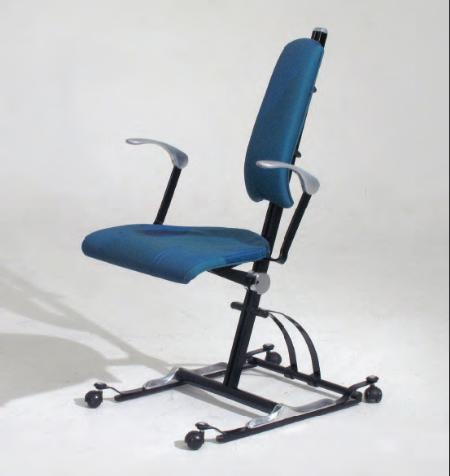
End.